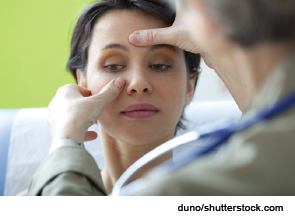
Rhinitis can arise as a side effect to a broad array of drugs.
A group of panelists discussed some of the potential causes of the condition, as well as new approaches to diagnosis and treatment.
Causes of nonallergic rhinitis can be immunologic, infectious, drug-induced, structural, hormonal, vasculitic, metabolic, and atrophic, among other categories, said panel moderator John Krouse, MD, PhD, chair of otolaryngology-head and neck surgery at Temple University School of Medicine in Philadelphia.
It’s traditionally been a diagnosis of exclusion. Patients present with sneezing, runny nose, postnasal drip, and nasal congestion promoted through several triggers, with lack of a skin test or in vitro demonstration of IgE-mediated allergic disease and no response to traditional treatments for allergic rhinitis.
Rhinitis can arise as a side effect to a broad array of drugs, from decongestants to antidepressants, from calcium channel blockers to aspirin, said Stephanie Joe, MD, associate professor of otolaryngology and director of The Nasal and Sinus Center at the University of Illinois at Chicago.
This cause of NAR is especially tricky to pinpoint, because the culprit medications are serving some kind of need, Dr. Joe said. “It’s difficult, because obviously you have to weigh the benefits and the risks and the side effects of taking these medications versus getting proper treatment and relief,” she said. “And that’s where the patient education plays into it very heavily.”
Patients can experience headaches when tapering off nasal decongestants such as Afrin, and panelists suggested allowing the patient to spray only one nostril per day—or even giving them saline to spray instead, to satisfy the urge.
Working Conditions
Nonallergic rhinitis brought about by working conditions, such as inhalation of chemicals or exposure to dust, can be difficult to assess because the mechanism might not be clear, said Elina Toskala, MD, PhD, professor of otolaryngology-head and neck surgery at Temple.
A group set up by the National Institutes of Health, the Non-Allergic Rhinitis Work Group, studied whether exposure to occupational agents can produce rhinitis symptoms by way of nonallergic mechanisms.
The group reviewed 27 articles and found that the literature on occupational nonallergic rhinitis is hindered by a lack of objective physiological testing and longitudinal follow-up, as well as by the potential for being confounded by simultaneous allergen exposure. But, they said, numerous studies support the idea that exposure to occupational agents can cause nasal symptoms in ways other than the allergic mechanism.
In trying to determine whether someone’s symptoms are work-related, she said, “One simple, most important question is: Do your symptoms get better when you’re away from work? The weekend might not be enough…but what about a vacation? You’re a week away from work.”
In discussing the case of a 25-year-old with rhinitis caused by wood dust, panelists recommended using a mask and making sure the building was properly ventilated. Dr. Toskala said she would treat with nasal steroids, but her first choice was more drastic: “If I could make a choice, I would say change his work.”
Local Allergenic Rhinitis
William Reisacher, MD, assistant professor of otorhinolaryngology and the director of allergy within the department of otolaryngology-head and neck surgery at Weill Cornell Medical College in New York, said that in some of the more vexing cases, physicians should consider the possibility of local allergic rhinitis, and it may not be NAR or traditional allergic rhinitis.
He started looking into this condition because he had patients who really looked to him as if they had allergic rhinitis. The patients themselves thought they had allergic rhinitis. But, he said, all of the testing came back negative. “The conversation would go something like this, ‘No, you don’t have allergies.’ ‘Yes, I do have allergies.’ ‘No, you don’t have allergies.’”
“The creation of local IgE can happen right in the nasal mucosa,” he said. “And that’s a switch from previous thinking that it had to occur in the larger lymphoid structures in the body like the spleen and the larger lymph nodes. Now we understand that the mucosa has all the machinery it needs to undergo that process and produce its own specific IgE.”
Tests for local allergic rhinitis include lavage, suction, nasal allergen provocation, surgical biopsy, and mucosal brush biopsy. A 2011 study found that immunotherapy offered benefits similar to those seen in patients with traditional allergic rhinitis.
Optical Rhinometry
Amber Luong, MD, PhD, assistant professor of otorhinolaryngology at the University of Texas Medical School in Houston, offered some hope for a more effective way to diagnose nonallergic rhinitis—by monitoring blood flow to the nose after exposure to capsaicin. “The problem is, a diagnosis of exclusion … doesn’t have a very good pre-test probability. You don’t feel that great about that diagnosis.”
The approach involves using optical rhinometry, a procedure in which a patient wears a device that looks like a pair of glasses with an emitter and a sensor that sits across the patient’s nose. This instrument indirectly monitors blood flow in and out of the nose, and that information is used as an indirect measure of nasal congestion.
Studies involving capsaicin exposure and comparing healthy controls with patients who have a history that is consistent with nonallergic rhinitis have found that optical density readings reach significance at much lower dosages of capsaicin in the NAR patients. “Now we have this potential device that maybe will allow us in the office to be able to…diagnose nonallergic irritant rhinitis,” Dr. Luong said.
After the panel concluded, Dr. Krouse said that he hopes the session is a reminder for otolaryngologists to consider the full array of rhinitis causes. “People can develop rhinitis symptoms at any age, and it’s not always related to allergy, as many people might assume,” he said. “There are lots of irritant effects. There are lots of medication effects, and many of these can cause nasal and sinus symptoms, so we need to take a very broad view of what might be triggering someone’s nasal symptoms.”